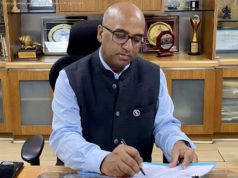Fostered by the University of Michigan, testing and research programs draw companies and even equip residents’ vehicles to collect and transmit data.
ANN ARBOR, Mich. — As the world looks ahead to a future of interconnected, self-driving cars, this college town 40 miles west of Detroit has emerged as a one-of-a-kind, living laboratory for the technologies that will pave the way.
Here, it is not uncommon to see self-driving Ford Fusions or Lexus sedans winding their way through downtown streets and busy intersections, occupied by engineers with eyes focused more on laptops and test equipment than the roadway.
Soon students and staff members at the University of Michigan will be able to get around the engineering campus on fully automated, driverless shuttle buses provided by a French company drawn to Ann Arbor by the university’s autonomous-car test track, known as MCity.
And at any time of the day, some 1,500 cars — owned by university employees, businesses and local residents, and wired up by university researchers — radio their speed and direction to one another and to equipment like traffic lights and crosswalk signals. It is all part of a vast pilot project run by the university to develop connected-car technologies that someday should ease congestion and make self-driving cars safe.
“This combination of research and testing in a controlled facility like MCity, and testing on the street in the real world, on this scale, doesn’ t exist anywhere else in the world, ” said James R. Sayer, director of the University of Michigan Transportation Research Institute.
Glenn Stevens can attest to that. An executive with a business organization that promotes the Detroit area’s autonomous vehicle activities, he recently met with groups from the Netherlands, Germany and India.
“We’ re constantly hosting companies from every continent, ” Mr. Stevens said.
And Ann Arbor is not alone. Thanks to its long automotive history, Michigan is the site of a broad array of research efforts and development centers that are focusing on connected cars and autonomous vehicles. In addition, Michigan has passed laws clearing the way for extensive testing on public roads — even for self-driving vehicles that have no steering wheels — and has equipped more than 100 public highways with electronics to facilitate testing of connected cars and self-driving trucks.
The competition to lead in a new era of self-driving cars is fierce. Silicon Valley, the Phoenix area and Pittsburgh are hotbeds, as are Singapore and Shanghai. In Europe, researchers have pushed ahead on tests of platoons of self-driving trucks.
“We are doing a lot of tests ourselves in the Netherlands on connected vehicles, and are looking at other places that have the same ambitions, ” Bram Hendrix, a representative of a Dutch auto industry association, said during a pause in a tour of Ann Arbor and the surrounding region. “We are here to see and learn so we can collaborate with this region.”
One of the strongest draws to Ann Arbor is MCity, a 32-acre testing ground that opened in 2015. It features simulated city streets, intersections and storefronts where carmakers and others can test self-driving vehicles in a confined but realistic setting. Dozens of companies, including General Motors, Toyota, Honda, BMW and Intel, are conducting research there in collaboration with the university.
Last winter they were joined by Navya, a French start-up that has developed a small, autonomous shuttle bus. Two will go into service at the university in September in one of the first trials of a driverless transit vehicle open to the public. By the end of the year, Navya plans to begin building its buses near Ann Arbor.
Henri Coron, Navya’s vice president for sales, said the decision to locate the assembly plant in Michigan was based on “the strength of support” from the university.
The university’s president, Mark Schlissel, said his institution was trying to ensure that Michigan remains a vibrant center of automotive innovation, even as Silicon Valley and other locations take prominent roles in developing self-driving cars.
“We want to provide the research underpinning for the state to succeed in competing in this future of mobility, ” he said. “For the economic future of the state, it is critical that the leadership of automotive technology remains in southeastern Michigan.”
The least visible of the university’s research efforts is its largest: the on-road test of vehicle-to-vehicle, or V2V, communications involving 1,500 cars, trucks and buses. Auto industry executives said they knew of no other live test of this scale anywhere in the world.
The vehicles in the project have been equipped with small radio transmitters that broadcast their speed and direction 10 times per second. At more than two dozen intersections, traffic lights and crosswalks have similar transmitters, allowing them to communicate with the vehicles.
The aim is to develop V2V technologies that will help improve traffic flow, Dr. Sayer said. “If a car is stopped 200 feet from a traffic light, you know there’s a long line of cars there, ” he said. “So you could lengthen the green light dynamically to reduce congestion.”
Preventing accidents is part of the plan. On a recent afternoon, MCity researchers demonstrated what they are working toward. In one test, a self-driving car approached a curve obscured by hedges, and suddenly slowed. Why? Because beyond the hedges another car stopped in the road had broadcast its position, warning the self-driving car of the hazard.
In another demonstration, a car driving at near highway speed jammed on the brakes. The hard braking action sent out a warning to a following vehicle to slow down. “You can get that signal even if the car is braking 1,000 feet down the road, so you can begin to brake even before you see the car, ” Dr. Sayer said.
This fall, the university’s V2V work will expand into a new area. Electronics at crosswalks will be able to pick up the Wi-Fi signal from cellphones and alert approaching cars that a pedestrian is starting to cross the road.
The university expects to expand the number of wired cars taking part in the trials to 2,500 by 2018.
The Toyota development arm working on self-driving cars is in Ann Arbor. Other automakers have set up comparable operations elsewhere in the state. General Motors is assembling self-driving test vehicles, based on its Bolt electric car, in Orion Township.






